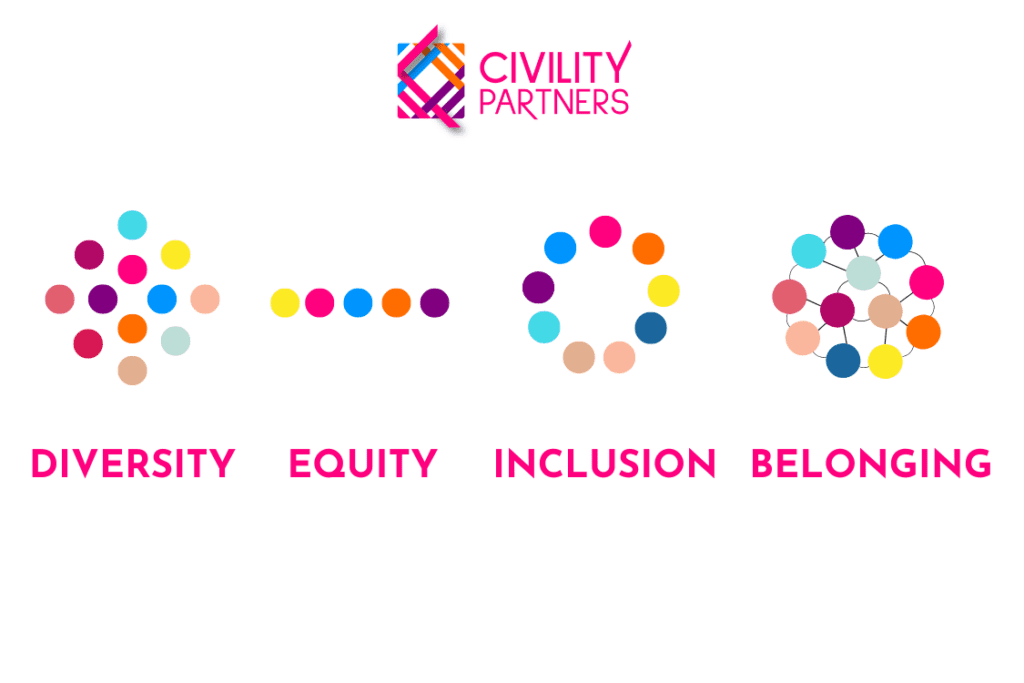We often start by assessing our clients’ cultures to understand whether relationships are healthy and if people perceive the organization as inclusive or not. Once we understand the opportunities for improvement, we can provide training and development opportunities for employees and leaders, and create and implement strategies to promote diversity, equity, and inclusion in the workplace.
But what does DEI really mean? The three concepts—which are interrelated but distinct—are crucial for developing a supportive and respectful working culture.
Diversity
Diversity refers to the range of qualities that distinguish groups of people from other groups of people. Often described in a trifecta of sex/gender, race/ethnicity, and physical abilities, the list of what makes us diverse is much longer. Diversity is any difference among people and their physical characteristics, behaviors, values, worldview, needs and more. Beyond the trifecta, consider that diversity is also about:
- Gender expression and gender identity
- Sexual orientation
- Religious beliefs and values
- Age
- Socioeconomic status
- Parental status, and thoughts or views on parenting decisions
- Politics
- Medical conditions
- Military or veteran status
- Cultural styles
- Diversity in thought, and in communication style
In order to welcome a diverse population into the workforce, we all have to recognize and appreciate people’s differences. We need to acknowledge that people have a variety of experiences and backgrounds, which adds value to businesses.
Equity
Equity refers to the fair and just treatment of all individuals, regardless of their diverse characteristics. It means ensuring that everyone has equal access to opportunities and resources so that everyone has an equal chance to succeed. That means barriers preventing some individuals from succeeding must also be removed.
And so the conversation about systemic discrimination begins. Employers everywhere must actively address historical bias or discriminatory practices and give historically underrepresented groups more resources or support.
Please keep in mind that just because you may not see systemic discrimination easily, it’s likely there. If your organization is focused on DEI, your organization must be willing to take a long, hard look at themselves in the mirror. Look at your vendors, for example, how many of them are Black or woman-owned? Where do your recruiting efforts fall short of bringing in a diverse pool of candidates? Is your website and the customer experience in your online client portal easy for all customers, or just most of them? Does your work schedule meet the needs of single parents or the sandwich generation?
These are just some of the areas where your systems may need a revamp to ensure they’re more equitable.
Inclusion
Inclusion refers to creating a culture where all individuals feel welcomed, respected, and valued. It is creating a sense of belonging for everyone.
This means that everyone should feel that they are part of the organization, that their contributions are valued, and that they are respected and treated fairly. It also involves fostering a culture in which everyone is motivated to engage and collaborate, and free to express their thoughts.
I’m sure you’ve heard or seen the famous Verna Meyers quote: “Diversity is being invited to the party. Inclusion is being asked to dance.”
Belonging
However, that famous quote leaves out the newest term to be added to the DEI acronym, Belonging. This blog post notes that belonging goes beyond dancing, and is about being asked for input on the music playlist, and feeling free to ask anyone you want to dance with you. Another post points out that being asked to dance insinuates someone else controls the pace and space of the dance floor… so it’s missing the whole point of DEIB work.
There are significant differences between being asked to dance because you’re a guest in someone else’s home, and being asked to create and build the home and plan the party inside of it. Belonging means that underrepresented groups feel as much ability as the “main group” to step in, fully participate, and influence the outcomes.
Belonging is also where the business can see real benefits, because people see an openness to their comments and questions, which inspires them to continue to share them. Then everyone starts to see the real benefits of being open to those comments and questions through their team’s work and output.
We’re always focused on creating environments where everyone feels valued, respected, included, and as if they belong (i.e., feel psychologically safe). Where everyone has an equal opportunity to succeed because the systems have made it possible by removing barriers, the people are inviting groups in, and the organization is celebrating full participation and influence from all members of the workforce, no matter what groups they may belong to.
Sincerely,
Catherine, Jenny, & The Civility Partners Team



